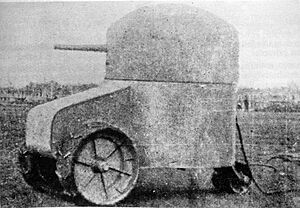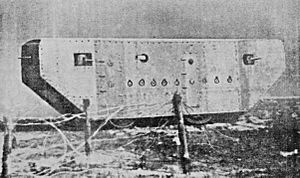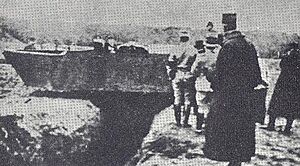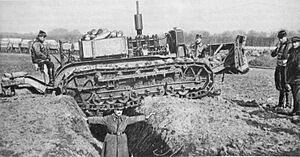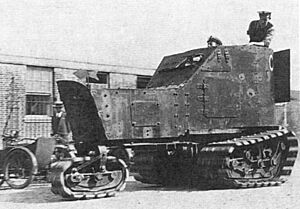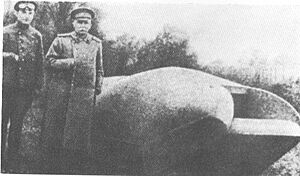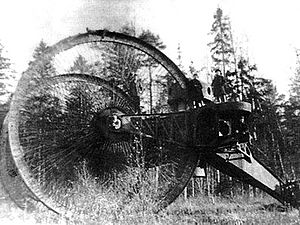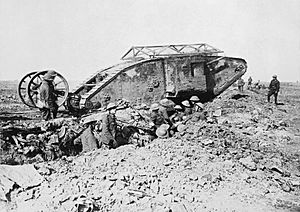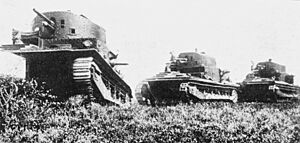History of the tank facts for kids
The history of the tank is about how these amazing armored vehicles came to be. Tanks are special machines designed to move forward in battle, staying safe from enemy attacks.
Contents
How Tanks Began
The idea of protecting soldiers from enemy attacks is very old. People have tried to use armor since ancient times!
The Industrial Revolution's Role
The invention of the explosion engine made it much easier to move heavy armored vehicles. Before this, horses were used. One of the first times an armored motor vehicle was used was during the Crimean War.
Developing the Tank
World War I created a huge need for new weapons. Soldiers needed armored vehicles that could move across any kind of land. This led to the invention of the tank! Before tanks, armored cars existed. But they could only move on smooth ground. New ideas were needed for rough terrain.
Tanks were first made to solve a big problem: the stalemate of the trenches on the Western Front. Soldiers were stuck in long ditches, and it was hard to attack. Tanks were designed to cross the dangerous "killing zone" between trenches. They could break through enemy defenses. These armored machines could stop bullets and shell pieces. They could also crush barbed wire, which infantry soldiers couldn't do. This helped break the deadlock in the war.
During World War I, few people realized how important the internal combustion engine would become. This engine made tanks possible. Later, it led to powerful mechanized forces. These forces took over the old jobs of horse cavalry. They also helped soldiers move more freely on the battlefield.
About 20 years later, these powerful machines became the tanks of World War II. They had increased firepower and protection. When tanks were combined with self-propelled artillery, armoured personnel carriers, and aviation, commanders could move their forces much better.
People had imagined armored vehicles for a long time. But with the start of trench warfare in World War I, both the Allied French and British worked on tanks at the same time.
Early Tank Ideas
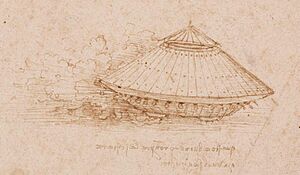
Leonardo da Vinci is often said to have designed a war machine like a tank. This was back in the 15th century! Later, in the 15th century, a Hussite named Jan Žižka used armored wagons with cannons. These cannons could fire through holes in the sides. But his idea wasn't used again until the 20th century. In the 17th century, Gottfried Wilhelm Leibniz thought up a "fire cart." It used a gunpowder engine to move. This was an early idea for using an engine to power a tank.
In 1903, a French captain named Léon Levavasseur suggested a "self-propelled cannon." It would move on a caterpillar system. It would also be fully armored for protection. This machine would have had a crew of three. It could also carry ammunition and move across rough land. But the idea was put aside.
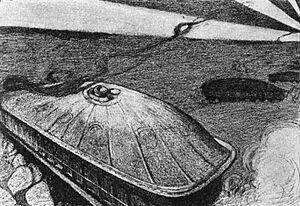
H. G. Wells wrote a short story in 1903 called "The Land Ironclads." He described large, armed, armored vehicles. They moved across country using special "pedrail wheels." These vehicles would break through fortified trenches. They would clear the way for infantry soldiers to advance.
Before World War I, two practical tank-like designs were suggested. But they were not built. In 1911, an Austrian officer named Günther Burstyn proposed a fighting vehicle. It had a gun in a rotating turret. In 1912, an Australian engineer named Lancelot de Mole showed a model of a fully tracked vehicle. Both of these ideas were rejected by their governments.
American Tracked Tractors
Benjamin Holt of the Holt Manufacturing Company was the first to patent a working crawler type tractor in the US. This was in 1907. He traveled to England in 1903 to learn about new developments. But the machines he saw there failed their tests. Holt then bought the rights to produce vehicles under another patent.
Holt went back to California. He used his knowledge to design and build practical continuous tracks for tractors. In England, David Roberts also got a patent for a similar design in 1904. Holt put wooden tracks on a 40-horsepower steamer. In November 1904, he successfully tested it on muddy land.
When World War I began, armies needed to move supplies to the front lines. The powerful pulling ability of crawling-type tractors caught their attention. Holt tractors were used to pull artillery and other supplies. The British army also used them to pull long trains of wagons. These wagons moved over rough dirt roads behind the front. Holt tractors were a big inspiration for the British and French tanks.
By 1916, about 1,000 Holt Caterpillar tractors were used by the British in World War I. A Holt vice president said these tractors weighed about 18,000 pounds. They had 120 horsepower. By the end of the war, 10,000 Holt vehicles had been used by the Allies.
French Tank Development
French Colonel Jean-Baptiste Eugène Estienne had a clear idea for a cross-country armored vehicle. On August 24, 1914, he said: "Victory in this war will belong to the belligerent who is the first to put a cannon on a vehicle capable of moving on all kinds of terrain."
Some private Holt tractors were used by the French Army early in World War I. They pulled heavy artillery in tough areas. But France did not buy many Holts. It was seeing the British use them that inspired Estienne. He then had plans drawn for an armored body on caterpillar tracks. Meanwhile, several attempts were made to design vehicles that could get past German barbed wire and trenches.
From 1914 to 1915, the Boirault machine was tested. Its goal was to flatten barbed wire and cross gaps. This machine had huge parallel tracks. They were made of 4x3 meter metal frames. These frames rotated around a triangular motorized center. But the machine was too weak and slow. It also couldn't change direction easily, so it was stopped.
In France, on December 1, 1914, Paul Frot proposed a "landship." It would have armor and weapons. It was based on a compactor with heavy wheels. The Frot-Laffly was tested in March 1915. It successfully destroyed barbed wire lines. But it was not mobile enough. The project was abandoned. Instead, they focused on General Estienne's idea using a tractor base.
In 1915, other vehicles were developed. They had strong armor and weapons. They were mounted on agricultural tractor chassis with large, rough wheels. One example was the Aubriot-Gabet "Fortress." This vehicle was powered by electricity and had a 37mm Navy cannon. But it also proved impractical.
In January 1915, Schneider & Co. sent its chief designer, Eugène Brillié, to England. He was to study tracked tractors from the American Holt Manufacturing Company. These tractors were being tested for wire-cutting machines. When Brillié returned, he convinced his company to start designing an "armored and armed tractor." It would be based on the "Baby Holt" chassis. Two of these were ordered.
Tests on the Holt caterpillar tracks began in May 1915. They showed that the 45-horsepower "Baby Holt" was better. On June 16, more tests were done. The President of France watched these tests. On September 10, Commander Ferrus also saw them. The first full chassis with armor was shown to the French Army on December 9, 1915. This was at Souain, with Colonel Estienne present.
On December 12, Estienne presented a plan to create an armored force. He didn't know about the Schneider tests. He was connected with Schneider. On January 31, 1916, Commander-in-chief Joffre ordered 400 tanks of the type designed by Brillié and Estienne. The actual order for 400 Schneider CA1 tanks was made on February 25, 1916. Soon after, on April 8, 1916, another order for 400 Saint-Chamond tanks was placed. Schneider had trouble making tanks on time. Deliveries were spread out from September 8, 1916. The Saint-Chamond tanks started arriving from April 27, 1917.
British Tank Development
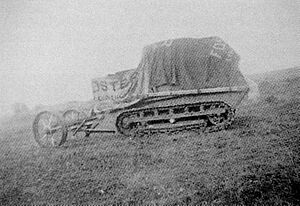
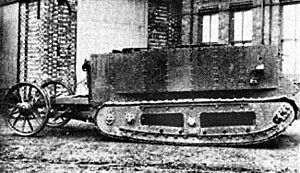
In 1914, the British War Office ordered a Holt tractor. They tested it at Aldershot. The 75-horsepower Holt was better at pulling heavy loads over rough ground. It was not as powerful as the 105-horsepower Foster-Daimler tractor. Without a load, the Holt tractor could go 4 miles per hour. With a load, it could go 2 miles per hour. Most importantly, Holt tractors were easy to get in large numbers. The War Office was impressed and chose it as a gun-tractor.
In July 1914, Lt. Col. Ernest Dunlop Swinton, a British officer, learned about Holt tractors. He heard they could move well in rough areas. He passed this information to the transport department. When World War I started, Swinton was sent to France. In October 1914, he realized the army needed a "machine-gun destroyer." This would be an armed vehicle that could move across country. He remembered the Holt tractor. He decided it could be the base for an armored vehicle.
Swinton suggested building a bullet-proof, tracked vehicle. It would be power-driven and could destroy enemy guns. He wrote a letter to Sir Maurice Hankey, who was part of the British Committee of Imperial Defence. Hankey convinced the War Office to test a Holt tractor on February 17, 1915. But the tractor got stuck in the mud. The project was stopped, and the War Office gave up.
In May 1915, the War Office tested a new trench-crossing machine. It was called the Tritton Trench-Crosser. This machine had large tractor wheels, 8 feet in diameter. It carried girders on a chain. These girders would be lowered over a trench. Then the back wheels could roll over it. The machine would drag the girder behind it. Once on flat ground, it would reverse to put the girders back in front. But the machine was too big and clumsy. It was abandoned.
When Winston Churchill, who was First Lord of the Admiralty, heard about the armored tractor idea, he brought it back. The Royal Navy and the Landship Committee agreed to support tests of armored tractors. They called them "land ships." In March, Churchill ordered 18 experimental landships to be built. Twelve would use Diplock pedrails. Six would use large wheels. But building them didn't go forward. The wheels seemed impractical. They were planned to be 40 feet in diameter. But they were still too big and fragile at 15 feet. The pedrails also had problems. The system was too large, too complex, and not powerful enough.
Instead of using the Holt tractor, the British government chose a British company. It was Foster and Sons. Its managing director and designer was Sir William Tritton.
All these projects failed by June 1915. The ideas for huge landships were abandoned. A decision was made to try using US Bullock Creeping Grip caterpillar tracks. They would connect two of them to make a flexible chassis. Tests failed in July 1915.
Another test was done with an American Killen-Strait tracked tractor. A wire-cutting device was successfully added. But the vehicle couldn't cross trenches well enough. An armored car body was added, making it the first armored tracked vehicle. But this project was also stopped. It couldn't meet the needs for all-terrain warfare.
After these tests, the Committee decided to build a smaller experimental landship. It would be half the size of the articulated version. It would use lengthened US-made Bullock Creeping Grip caterpillar tracks. This new machine was called the No1 Lincoln Machine. Building started on August 11, 1915. The first tests began on September 10, 1915. But these tests failed because the tracks were not good enough.
Development continued with new tracks designed by William Tritton. The machine was renamed Little Willie. It was finished in December 1915 and tested on December 3, 1915. Its ability to cross trenches was not good enough. So, Walter Gordon Wilson developed a new rhomboidal design. This became known as "His Majesty's Landship Centipede" and later "Mother." This was the first of the "Big Willie" type of true tanks. It was completed on January 29, 1916. Tests were very successful. The War Office ordered 100 units for the Western Front in France on February 12, 1916. A second order for 50 more units was placed in April 1916.
France started studying caterpillar tracks in January 1915. Actual tests began in May 1915. This was two months before the Little Willie tests. At the Souain experiment, France tested an armored tracked tank prototype. This was in the same month Little Willie was finished. However, the British were the first to use tanks in battle. This was at the Battle of the Somme in September 1916.
Why It's Called a "Tank"
The name "tank" was first used in December 1915. It was a secret code name. This name has been used in many languages since then. William Tritton said that when the first tanks were being built, their real purpose was hidden. The paperwork called them "water carriers." Workers thought they were for the Mesopotamian Front. Workers started calling them "water tanks" or just "tanks." In October, the Landships Committee decided to change its name to something less obvious.
One member, Ernest Swinton, suggested "tank." The committee agreed. The name "tank" was used in official papers from then on. The Landships Committee was renamed the Tank Supply Committee. Sometimes, people confuse this with the labels on the first production tanks. These tanks had a Russian caption that said "With Care to Petrograd." This was probably inspired by the workers at Foster's. Some workers thought the machines were snowplows for Russia. This label was used from May 15, 1916. The Committee was happy to let this idea continue. It might mislead the Germans.
The tank's development by the navy also explains why some tank parts have nautical names. These include hatch, hull, bow, and ports. There was great secrecy around tank development. Also, infantry commanders were often doubtful about tanks. This meant that infantry soldiers often had little training on how to work with tanks.
Russian Tank Ideas
Vasily Mendeleev, a shipyard engineer, worked on a design for a super-heavy tank. This was from 1911 to 1915. It was a very heavily armored 170-ton tracked vehicle. It had a 120mm naval gun. The design included many new ideas that became standard on modern tanks. Its protection was well thought out. The gun had an automatic loading system. Air suspension allowed the tank to adjust its height. Some important systems were duplicated. It could even be transported by train. But it would have cost almost as much as a submarine. So, it was never built.
The Vezdekhod was a small vehicle designed by Aleksandr Porokhovschikov. It ran on a single wide rubber track. It was powered by a 10-horsepower engine. Two small wheels on the sides helped with steering. The vehicle could cross ground well, but its steering didn't work well. After the Russian Revolution, the Vezdekhod was shown as the first tank in propaganda.
The Tsar Tank was also known as the Lebedenko tank. It had a tricycle design with front wheels 9 meters high. Designers thought these huge wheels could cross any obstacle. But the design was flawed. Most of the weight was on the smaller rear wheel. It got stuck when tested in 1915. The designers were ready to put bigger engines in it. But the project and the vehicle were abandoned.
German Tank Development
The A7V was the only German tank in World War I that fought in battles. A prototype was built in early 1917 for testing. Production began in October of that year. They were used about six times starting in March 1918. Only twenty were made. Germany also had other tank projects on paper and other prototypes being developed.
Tanks in Action
World War I Battles
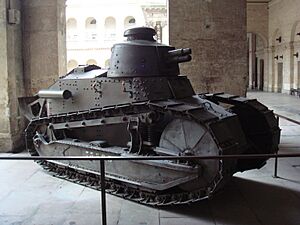
The first attack using tanks happened on September 15, 1916. This was during the Battle of the Somme. Forty-nine Mark I tanks were used. Thirty-two of them were able to move forward. They had some small, local successes. In July 1917, 216 British tanks were used in the Third Battle of Ypres. But they found it almost impossible to move in the muddy conditions. They achieved little. It wasn't until November 20, 1917, at Cambrai, that the British Tank Corps had the right conditions. Over 400 tanks broke through almost 6 miles on a 7-mile wide front.
However, the success was not complete. The infantry soldiers didn't follow up and secure the gains. Almost all the land gained was taken back by the Germans. The Australian, Canadian, and British forces had a much bigger victory the next year. This was on August 8, 1918, with 600 tanks in the Battle of Amiens. General Erich Ludendorff called that day the "Black Day" of the German Army.
While the British were developing tanks, France designed its own. The first two were the medium Schneider CA and the heavy Saint-Chamond. They were not well designed. But they were made in large numbers. The Saint-Chamond had an electro-mechanical transmission and a long 75mm gun. Both types fought in many battles. But they often had high losses. In 1918, the Renault FT light tank was the first with a "modern" design. It had a rotating turret on top and an engine at the back. It became the most common tank of the war. A later development was the super-heavy Char 2C. This was the largest tank ever to serve. It appeared some years after the war ended.
Germany's response to the Cambrai attack was to develop its own tanks. Soon, the huge A7V appeared. It weighed 30 tons and had a crew of eighteen. By the end of the war, only twenty had been built. Germany had other tanks planned. But a lack of materials limited their tank force. They only had these A7Vs and about 36 captured Mark IVs. The A7V was in the first tank-versus-tank battle of the war. This was on April 24, 1918, at the Second Battle of Villers-Bretonneux. There was no clear winner in that battle.
Many mechanical problems and the inability of the British and French to keep attacks going made people doubt tanks. By 1918, tanks were very easy to attack. This was unless they were with infantry and ground-attack aircraft. These helped find and stop anti-tank defenses.
General John J. Pershing, who led the American Expeditionary Forces (AEF), asked for tanks. In September 1917, he requested 600 heavy and 1,200 light tanks from the United States. When Pershing took command, he brought Lt. Col. George Patton with him. Patton became very interested in tanks. At that time, tanks were clumsy, unreliable, and unproven. Many people doubted their use in battle. Against the advice of his friends, Patton chose to join the new US Tank Corps. He was the first officer assigned to it.
The first American-made heavy tank was the 43.5-ton Mark VIII. It was also called the "Liberty." This was a US-British design based on the successful British heavy tank. It was meant for the Allied forces. It had two 6-pounder cannons and five machine guns. It had a crew of 11. Its top speed was 6.5 miles per hour. It could travel 50 miles. Because of production problems, only test vehicles were finished before the war ended.
The American-built 6.5-ton M1917 light tank was a copy of the French Renault FT. It had a top speed of 5.5 miles per hour. It could travel 30 miles on 30 gallons of fuel. Again, because of production delays, none were finished in time for battle. In the summer of 1918, a 3-ton, 2-man tank was designed. It was made by the Ford Motor Company. It was powered by two Ford Model T engines. It had a .30 inch machine gun. Its top speed was 8 miles per hour. It was not considered good for fighting. But it might be useful for other jobs on the battlefield. An order was placed for 15,000. But only 15 were finished, and none saw service in the war.
American tank units first fought on September 12, 1918. This was against the Saint-Mihiel salient. They were from the 344th and 345th Light Tank Battalions. These were part of the 304th Tank Brigade. Lt. Col. Patton commanded them. They had trained under him in France. They used Renault FT tanks supplied by France. Mud, lack of fuel, and mechanical problems caused many tanks to get stuck. But the attack succeeded. Much valuable experience was gained. By the end of the war, the AEF had very few tanks. No American-made ones were ready for combat.
Between the World Wars
After World War I, General Erich Ludendorff of Germany praised Allied tanks. He said they were a main reason for Germany's defeat. The Germans had realized their value too late. Even if their factories could have made many tanks, fuel was very scarce. Of the 90 tanks Germany used in 1918, 75 were captured from the Allies.
US tank units fought for a short time in the war. They were also spread out. The number of tanks they had was very limited. So, there was almost no chance to develop tactics for using many tanks at once. Still, their work was impressive enough. It made some military leaders think that using tanks in large groups would be important in the future.
The US Army learned several things about tanks from combat. They needed tanks with more power and fewer mechanical problems. They also needed heavier armor, longer range, and better air flow. Tanks needed to train with other combat groups, especially infantry. They also needed better ways to communicate and navigate. Finally, they needed a better supply system, especially for petrol and ammunition.
At the end of the war, tanks were mainly seen as support for infantry. World War I tanks were slow, clumsy, hard to control, and unreliable. But their value as a weapon was clear. Despite these lessons, military groups were slow to accept tanks as a separate force. They kept arguing about how to use tanks properly. At first, most people thought tanks were just an extra part of the infantry. But a few leaders argued that tanks should be their own independent group.
Besides light and heavy tanks from World War I, a third type, the medium tank, got attention in 1919. People hoped this in-between type would combine the best features of the 6.5-ton light and the Mark VIII heavy tanks. It would replace both. The meaning of light, medium, and heavy tanks changed between the wars. In World War I, light tanks were up to 10 tons. Medium tanks were about 10 to 25 tons. Heavy tanks were over 25 tons. For World War II, tanks got heavier. Light tanks were over 20 tons. Medium tanks were over 30 tons. Heavy tanks, developed later in the war, were over 60 tons. Between the wars, tank weights varied within these ranges.
The US National Defense Act of 1920 put the Tank Corps under the Infantry. The Act said that "all tank units shall form a part of the Infantry." This made the tank's role clear for the near future. George Patton had argued for an independent Tank Corps. But if tanks had to be part of a traditional group, he preferred the cavalry. Patton understood that tanks with cavalry would focus on speed. Tanks tied to infantry would focus on firepower. He feared that tanks in peacetime "would be very much like coast artillery with a lot of machinery which never works."
Most soldiers saw tanks as special infantry support weapons for crossing trenches. But many officers in the Royal Tank Corps imagined bigger roles for mechanized forces. In May 1918, Col. J.F.C. Fuller, known as the father of tank ideas, used German tactics as an example. He refined his "Plan 1919." This was a detailed idea for a large armored attack in 1919.
The Royal Tank Corps had to use the same basic tanks from 1922 until 1938. British tank thinkers didn't always agree. B. H. Liddell Hart, a famous writer on armored warfare, wanted a combined force. It would have a big role for mechanized infantry. Fuller, Broad, and other officers were more interested in tanks alone. The Experimental Mechanized Force was formed by the British under Percy Hobart. It was a mobile force with its own self-propelled guns, infantry, and armored cars.
People who supported or opposed mechanization often used "tank" loosely. It meant not just an armored, tracked, turreted, gun vehicle. It also meant any armored vehicle or mechanized unit. This made it hard to know if someone was talking about pure tank forces, combined forces, or infantry mechanization.
British armored vehicles often focused on either speed or protection. Both the cavalry and the Royal Tank Corps wanted fast, lightly armored vehicles. These were for scouting and quick attacks. These were the light and medium (or "cruiser") tanks. In practice, "light tanks" were often small armored troop carriers. On the other hand, "army tank battalions" needed very heavy armor for infantry support. Because of these two roles, firepower was often not a main focus in tank design.
Among German supporters of mechanization, General Heinz Guderian was very important. In 1914, Guderian worked with radios supporting cavalry units. This made him insist on a radio in every armored vehicle. By 1929, Guderian believed it was useless to develop just tanks. He thought an entirely new mechanized force was needed. This force would combine all types of weapons. It would make the tank's effects as strong as possible.
The German tanks were not as good as Guderian's ideas. The Panzer I was a small tankette with machine guns. It came from the British Carden Loyd tankette. The Panzer II had a 20mm cannon. But it had little armor protection. These two vehicles made up most German tank units until 1940.
In the 1920s, France was the only country with a large armored force. French ideas saw combined arms as helping infantry move forward. Tanks were seen as "a sort of armored infantry." By law, they were part of the infantry branch. This meant armor was not just limited to tanks. The French army became one of the most mechanized.
Tanks were first seen as special breakthrough systems. They would be used in large numbers for attacks. Light tanks had to move at the speed of foot soldiers. Heavy tanks were meant to form a "shock front" to break enemy lines. The ideas focused a lot on how strong the enemy's defenses were. Artillery and air attacks had to destroy machine guns and anti-tank guns. The part where tanks would surround the enemy was not focused on. Even though they were part of the Infantry, tanks were often in pure tank units. They rarely trained with foot soldiers.
In 1931, France decided to make more armor and equipment. This included the Char B1 bis. The B1 bis was developed by Estienne in the early 1920s. It was still one of the most powerful tank designs 15 years later. In 1934, the French cavalry also started to mechanize. Tanks would be used for exploiting breakthroughs too.
As the French Army moved forward with mechanization, disagreements started. In 1934, Lieutenant Colonel Charles de Gaulle wrote "Towards the Professional Army." De Gaulle wanted a professional mechanized force. It would be able to break through and exploit enemy lines. He imagined a pure armored brigade moving in a line. A motorized infantry force would follow to clear up. His ideas were not adopted because they were too expensive.
From 1936, French tank production sped up. But the problems with ideas remained. This led to an inflexible structure in 1940. The Infantry and Cavalry had separate types of armored divisions.
In the 1920s and early 1930s, Soviet officers led by Marshal Mikhail Tukhachevsky developed "Deep Battle." This idea was to use infantry, cavalry, mechanized forces, and aircraft together. The Soviet government's first Five Year Plan expanded factories. They used design ideas from American inventor J. Walter Christie. By 1934, the Soviets made 5,000 armored vehicles. This allowed the Red Army to create tank units for infantry support and combined mechanized operations.
On June 12, 1937, the Soviet government executed Tukhachevsky and eight high-ranking officers. Stalin was purging Soviet society. At the same time, the Soviet experience in the Spanish Civil War made the Red Army rethink mechanization. Soviet tanks had too little armor. Their Russian crews couldn't talk to Spanish troops. In battle, tanks often moved too fast for the supporting infantry and artillery.
The United States was not as advanced in developing armored forces. Like in France, the old World War I tanks and tanks being part of the infantry slowed development. Tanks were only seen as direct infantry support. The US War Department's policy in April 1922 hurt tank development. It said the tank's main job was "to facilitate the uninterrupted advance of the riflemen in the attack."
The War Department thought two types of tanks, light and medium, should do all jobs. The light tank had to be transportable by truck. It could not weigh more than 5 tons. For the medium tank, limits were even stricter. Its weight could not be over 15 tons. This was so it could fit on railroad cars, average highway bridges, and pontoon bridges.
An experimental 15-ton tank, the M1924, was designed. But this and other attempts to meet requirements were not good enough. It was impossible to build a 15-ton vehicle that met all the needs.
In 1926, the General Staff reluctantly agreed to develop a 23-ton tank. But they made it clear that they still wanted a good 15-ton vehicle. The infantry also decided that a light tank, transportable by truck, was best. This was despite some tankmen wanting a more heavily armed medium tank. The focus on light tanks and limited money slowed the development of heavier vehicles. This led to a serious shortage of medium tanks when World War II started.
J. Walter Christie was a creative designer of tanks and engines. His designs didn't meet US Army needs. But other countries used his chassis patents. Despite not enough money, the Ordnance Department developed several experimental light and medium tanks. They tested one of Christie's models by 1929. None of these tanks were accepted. This was usually because they exceeded standards set by other Army branches.
For example, several light tank models were rejected. They were too heavy for the Transportation Corps trucks. Several medium tank designs were rejected. They were too heavy for the 15-ton bridge limit set by engineers. Christie didn't want to work with users to meet military needs. Instead, he wanted the Army to pay for the tanks he wanted to build.
The Christie tank could run on both tracks and large, solid-rubber-tired wheels. The tracks could be removed for use on wheels over easier ground. It also had a suspension system with independently sprung wheels. The Christie had many advantages. In 1929, it could reach amazing speeds: 69 miles per hour on wheels and 42 miles per hour on tracks. But at these speeds, the tank couldn't carry all its equipment.
The Ordnance Department saw the Christie's usefulness. But they thought it was unreliable. They also thought dual-purpose equipment was generally bad engineering. The debate over Christie tanks lasted more than 20 years. The idea of convertible tanks was dropped in 1938. But Christie's ideas greatly influenced tank tactics and organization in many countries, including the US Army.
In the United States, the real start of the Armored Force was in 1928. This was 12 years before it was officially created. Secretary of War Dwight F. Davis ordered that a tank force be developed. Earlier that year, he had been very impressed by a British experimental armored force he saw in England. The idea wasn't new. A small group of dedicated officers had been working on ideas for such a force since World War I.
Improvements in armor, weapons, engines, and vehicles gradually pushed towards more mechanization. The military value of horses declined. Supporters of mechanization pointed to advances in the motor vehicle industry. They also noted the decrease in using horses and mules. Also, the United States had a lot of oil. This gave them independence in fuel for machines.
Secretary Davis' 1928 order led to an experimental mechanized force. It was gathered at Camp Meade, Maryland, from July 1 to September 20, 1928. This team included elements from Infantry (with tanks), Cavalry, Field Artillery, Air Corps, Engineer Corps, and other services. An effort to continue the experiment in 1929 failed. This was due to not enough money and old equipment. But the 1928 exercise was fruitful. The War Department Mechanization Board recommended a permanent mechanized force.
As Chief of Staff from 1930 to 1935, Douglas MacArthur wanted to advance motorization and mechanization. In late 1931, all army branches were told to adopt mechanization "as far as is practicable and desirable." They could do research and experiments. Cavalry was given the job of developing combat vehicles. These would "enhance its power in roles of reconnaissance, counterreconnaissance, flank action, pursuit, and similar operations." By law, "tanks" belonged to the infantry. So, the cavalry bought "combat cars." These were lightly armored and armed tanks. They were often hard to tell apart from the newer infantry "tanks."
In 1933, MacArthur prepared for the cavalry to become fully mechanized. He said, "The horse has no higher degree of mobility today than he had a thousand years ago. The time has therefore arrived when the Cavalry arm must either replace or assist the horse as a means of transportation, or else pass into the limbo of discarded military formations." The horse was not yet called obsolete. But its competition was getting faster. Cavalrymen, sensing possible extinction, looked to replace horses with faster machines in their units.
In 1938, the War Department changed its 1931 order. Development of mechanization would only be done by two combat arms: cavalry and infantry. As late as 1938, the Chief of Cavalry, Maj. Gen. John Knowles Herr, said, "We must not be misled to our own detriment to assume that the untried machine can displace the proved and tried horse." He wanted a balanced force of both horse and mechanized cavalry. In 1939, he told a Congressional committee that horse cavalry had "stood the acid test of war." He said motor elements had not.
Overall, between the world wars, there was much talk but little real progress in US tank production and tactics. Only a few test models were built. Just 35 were made between 1920 and 1935. Regarding tanks with infantry, the official rules of 1939 were much like those of 1923. They said that "As a rule, tanks are employed to assist the advance of infantry foot troops, either preceding or accompanying the infantry assault echelon."
In the 1930s, the American Army started discussing how to combine tanks and airplanes. But the US Army remained focused on infantry. Even so, enough changes had happened to need serious study. In the spring of 1940, training exercises in Georgia and Louisiana showed how far US Army General Adna R. Chaffee Jr. had brought American armored ideas.
World War II Tanks
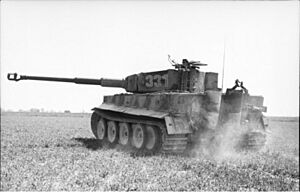
World War II forced armies to combine all available weapons. They needed mobile, flexible teams at every level. The mechanized combined arms force became very important in this war. In 1939, most armies still thought of an armored division as just a lot of tanks. They had limited support from other weapons. By 1943, these same armies had balanced armored divisions. These divisions had different weapons and services. Each part had to be as mobile and protected as the tanks they were with. This focus on mechanized forces in a few mobile divisions left regular infantry units without enough armor. So, German, Soviet, and American armies developed other tank-like vehicles. These included tank destroyers and assault guns. They performed these jobs with the infantry.
However, tank experts in most armies wanted to avoid being tied to the infantry. Tanks were also very complex, expensive, and rare weapons. The British continued to develop two types of tanks for much of the war. They had Infantry tanks to support infantry. They also had lighter, more mobile cruiser tanks for independent armored groups. The Soviets also made a series of heavy breakthrough tanks.
During the war, German tank design went through at least three stages. There were also constant small changes. The first stage included pre-war vehicles like the Panzer I and II. These were similar to Soviet and British light tanks. The Germans changed their tank battalions to mostly Panzer III and Panzer IV medium tanks after the 1940 French campaign. Then, many new T-34 and KV-1 Soviet tanks appeared. The Germans didn't know about them until 1941. This forced them to try to make tanks with better armor and gun power.
The third stage included many different types. But the most important designs were the Panther (Panzer V) and Tiger (Panzer VI) tanks. Unfortunately for the Germans, they lacked resources. They also focused on protection and firepower. Their designs were often too complex. This limited the number of tanks they could produce. However, an assault gun version of the Panzer III, the Sturmgeschütz III, became Germany's most produced armored vehicle. Over 9,300 were made. It was a popular design that could also be used as a dedicated anti-tank vehicle.
When Germany invaded western Europe in 1940, the US Army had only 28 new tanks. These were 18 medium and 10 light tanks. They soon became old. They also had about 900 older models. The Army had no heavy tanks and no plans for any. Even worse than the tank shortage was that industry lacked experience in tank making. Production facilities were limited. Also, the United States was committed to helping its allies. By 1942, American tank production had jumped to almost 25,000. This was almost double the combined British and German output for that year. In 1943, the peak year for tank production, the total was 29,497. In total, from 1940 through 1945, US tank production reached 88,410.
Tank designs in World War II were based on many complex ideas. But the main factors came from combat experience. Early battles showed that a bigger tank was not always a better tank. The goal became to combine all proven features in a good balance. Weight and size were only minor parts of this. The key features were mechanical reliability, firepower, mobility, and protection.
The problem was that adding even a little armor greatly increased the tank's total weight. This then needed a more powerful and heavier engine. This, in turn, led to a larger and heavier transmission and suspension system. This "vicious circle" of upgrading a tank's features often made it less maneuverable and slower. It also made it a larger and easier target. Finding the right armor thickness, balanced with other factors, was a big challenge. It led to many different ideas and disagreements.
According to Lt. Gen. Lesley J. McNair, the answer to bigger enemy tanks was more powerful guns, not bigger tanks.
Since light tanks were emphasized in 1940 and 1941, their production was almost two to one over medium tanks. But in 1943, as the demand for more powerful tanks grew, light tanks fell behind. By 1945, fewer than half as many light tanks were produced compared to medium tanks.
In 1945–46, the US European Theater of Operations studied past and future army organization. Tank destroyers were seen as too specialized for a peacetime army. The US Army then changed its mind. It concluded that "the medium tank is the best antitank weapon." While this might have been true, it didn't consider how hard it is to design a tank that can outshoot and defeat all other tanks.
Cold War Tanks
During the Cold War, there were two main opposing forces in Europe. These were the Warsaw Pact countries and the NATO countries.
The Soviet Union controlled the Warsaw Pact. This led to most countries using similar tank designs. In contrast, the main NATO countries—France, Germany, the USA, and the UK—developed their own tank designs. These had little in common.
After World War II, tank development continued. Tanks were still made in huge numbers. The technology also improved a lot. Medium tanks became heavier. Their armor got thicker, and their firepower increased. This slowly led to the idea of the main battle tank. Heavy tanks were gradually phased out. Gun technology also changed a lot, with better shell designs.
Many changes in tank design were improvements to aiming and range (fire control), gun stabilization, communications, and crew comfort. Armor improved to keep up with better weapons. The rise of composite armour was very important. Guns also became more powerful. However, the basic design of tanks didn't change much. It has stayed largely the same into the 21st century.
Post-Cold War Tanks
When the Cold War ended in 1991, people started asking if traditional tanks were still important. Over the years, many nations reduced their number of tanks. Or they replaced most of them with lighter armoured fighting vehicles. These had only minimal armor protection.
This period also ended the superpower groups. The military industries of Russia and Ukraine now compete to sell tanks worldwide. India and Pakistan have upgraded old tanks. They also bought new T-84s and T-90s from former Soviet states. Both countries have shown prototypes. These are not for their own use. They are designed to compete with the latest Western tanks on the market.
Ukraine has developed the T-84-120 Oplot. It can fire both NATO 120mm ammunition and ATGMs through its gun barrel. It has a new turret with an auto-loader. But it copies Western designs with an armored ammunition compartment. This improves crew safety.
The Russian Chyorny Oryol ("Black Eagle") is based on a longer T-80 hull. An early model was shown in 1997. It seemed to have much heavier armor. It also had a completely new modern turret that separated the crew and ammunition. The prototype has a 125mm tank gun. But it is said to be able to mount a new 152mm gun. Russia is also rumored to be developing the Obiekt 775 MBT. It is sometimes called T-95. It has a remote-controlled turret for use in Russia.
The Italian C1 Ariete MBT was one of the latest all-new main battle tanks. Deliveries ran from 1995 to 2002. This tank is almost the same size as the very first tank. Both are 8 feet (2.5 m) high. The Mark I was about 9.9 m long (hull). The Ariete is 7.6/9.52 m long (hull/hull+gun). However, the Ariete weighs more than double. It can also travel ten times faster. It weighs 54,000 kg compared to 25,401 kg. It can go 40 mph compared to 4 mph (60 km/h vs 6 km/h).
Some armies have thought about getting rid of tanks completely. They would go back to using wheeled anti-tank guns and infantry fighting vehicles (IFV). But there is a lot of resistance to this idea. All the great powers still have many tanks. They are either in active forces or ready reserves. There has been no proven alternative. Tanks have done well in recent conflicts.
Tanks are still vulnerable to many kinds of anti-tank weapons. They also need more supplies than lighter vehicles. But these were also true for the first tanks. In direct combat, tanks offer a great combination of survival and firepower. No other ground system matches this. Whether this combination is worth their cost is debated. There are also very effective anti-tank systems, IFVs, and air-based ground attack systems.
Because tanks are vulnerable to RPGs, they have always had local defense from machine guns. This helped in some cases. But it created another problem. The machine gun had to be operated by the commander from outside the tank. This made him vulnerable to enemy fire. To solve this, gun shields were made. But they didn't completely solve the problem. So, when the M1A2 TUSK (Tank Urban Survival Kit) was developed, a remote machine gun was added. It was one of the first main battle tanks to have one. Other tanks have also had this type of gun. For example, a 20mm remote cannon on the M60A2. This remote machine gun, called CROWS (Common Remotely Operated Weapons Station), solved the problem of the commander being exposed. It can also have an optional grenade launcher.
Perhaps one of the main ways tanks are improving this century is with active protection systems. Until 15 years ago, armor (reactive or passive) was the only way to protect against anti-tank weapons. The newest active protection systems (like Israeli TROPHY and Iron Fist, and Russian Arena) offer high survival rates. This is even against many RPGs and missiles. If these systems keep getting better, and are used on modern tanks, the fight between armor and anti-tank weapons will change completely. This means 21st-century tanks could become much more effective.
See also
 In Spanish: Historia del carro de combate para niños
In Spanish: Historia del carro de combate para niños
- Tank classification
- G-numbers (U.S. tanks)
- Tank guns
- Comparison of World War I tanks
- Tanks of the interwar period
- Comparison of early World War II tanks
- Post-Cold War Tanks
- Armoured fighting vehicle
- Cultivator No. 6





